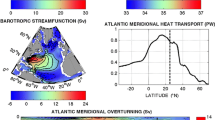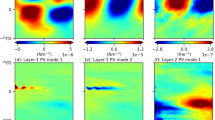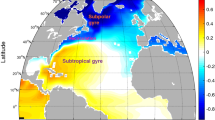Abstract
We formulate a box model of coupled ocean–atmosphere to examine the differential fields interactive with the thermohaline circulation (THC) and their response to global warming. We discern a robust convective bound on the atmospheric heat transport, which would divide the climate regime into warm and cold branches; but unlike the saline mode of previous box models, the cold state, if allowed, has the same-signed—though weaker—density contrast and THC as the present climate, which may explain its emergence from coupled general circulation models. We underscore the nondeterminacy of the THC due to random eddy shedding and apply the fluctuation theorem to constrain the shedding rate, thus closing the problem. The derivation reveals an ocean propelled toward the maximum entropy production (MEP) on millennial timescale (termed “MEP-adjustment”), the long timescale arising from the compounding effect of microscopic fluctuations in the shedding rate and their slight probability bias. Global warming may induce hysteresis between the two branches, like that seen in GCMs, but the cold transition is far more sensitive to the moistening than the heating effects as the latter would be countered by the hydrological feedback. The uni- or bi-modality of the current state—hence whether the THC may recover after the cold transition—depends on the global-mean convective flux and may not be easily assessed due to its observed uncertainty.




Similar content being viewed by others
Notes
It has been argued that the THC requires the wind work for its genesis on account of the Sandstrom theorem (Wunsch 2002), which however overlooks the dynamics that the thermal-induced pressure gradient can drive a flow. In addition, as discussed in Ou (2007), the varying wind work can be accommodated by changing thermocline depth (hence the potential energy) without impacting the THC to be derived here.
The net surface longwave (LW) flux and the outgoing LW radiation (OLR) are relatively uniform compared with the convective flux hence neglected in the differential heating. We have also neglected the atmospheric absorption of the SW flux, which does not enter the surface heat balance to be considered.
The exponent in the FT (19) needs to be dimensionless, and with the macroscopic variables appearing in it already nondimensionalized, so should the time. Here we posit that the only relevant timescale is the upper-ocean overturning time, to which our steady-state balances are also referenced.
This incidentally justifies the GCM practice of fixing the diapycnal diffusivity (a proxy of the admittance, see Sect. 1) after it is tuned for the current climate.
Since the convections at different sites need not all cease at the same time, it allows partial shut-down of the THC. On the other hand, the direct effect of the local convection on the THC has been previously questioned as the THC depends primarily on the large-scale density contrast (14) (Maroztke and Scott 1999; Jungclaus et al. 2006).
Since the current state and the attendant freshwater input are uniquely determined in our model, there is no need or justification for aligning the warm transition among model runs by Rahmstorf et al. (2005).
References
Auer SJ (1987) Five-year climatological survey of the Gulf Stream system and its associated rings. J Geophys Res 92:11709–11726
Bryan F (1987) Parameter sensitivity of primitive equation ocean general circulation models. J Phys Oceanogr 17:970–985
Bryan FO, Hecht MW, Smith RD (2007) Resolution convergence and sensitivity studies with North Atlantic circulation models. Part I: The western boundary current system. Ocean Model 16(3):141–159
Ciliberto S, Laroche C (1998) An experimental test of the Gallavotti-Cohen fluctuation theorem. J Phys IV France 4:1998629. doi:10.1051/jp
Crooks GE (1999) Entropy production fluctuation theorem and the nonequilibrium work relation for free energy differences. Phys Rev E 60(3):2721–2726
Dalan F, Stone P, Kamenkovich IV, Scott JR (2005) Sensitivity of the Ocean’s Climate to Diapycnal Diffusivity in an EMIC. Part I: Equilibrium State. J Clim 18:2460–2481
Dewar RC (2005a) Maximum entropy production and the fluctuation theorem. J Phys A Math Gen 38:L371–L381
Dewar RC (2005b) Maximum entropy production and nonequilibrium statistical mechanics. In: Kleidon A, Lorenz RD (eds) Non-equilibrium thermodynamics and the production of entropy: life, Earth, and beyond. Springer, Heidelberg
Dixon KW, Delworth TL, Spelman MJ, Stouffer RJ (1999) The influence of transient surface fluxes on North Atlantic overturning in a coupled GCM climate change experiment. Geophys Res Lett 26(17):2749–2752
Evans DJ, Cohen EGD, Morriss GP (1993) Probability of second law violations in shearing steady flows. Phys Rev Lett 71:2401–2404
Gill AE (1982) Atmosphere–Ocean dynamics. V30, Academic Press, USA
Gregory JM, Dixon KW, Stouffer RRJ, Weaver AJ, Driesschaert E, Eby M, Fichefet T, Hasumi H, Hu A, Jungclaus JH, Kamenkovich IV, Levermann A, Montoya M, Murakami S, Nawrath S, Oka A, Sokolov AP, Thorpe RB (2005) A model intercomparison of changes in the Atlantic thermohaline circulation in response to increasing atmospheric CO2 concentration. Geophys Res Lett 32:L12703. doi:10.1029/2005GL023209
Griffies SM, Winton M, Anderson WG, Benson R, Delworth TL, Dufour CO, Dunne JP, Goddard P, Morrison AK, Rosati A, Wittenberg AT (2015) Impacts on ocean heat from transient mesoscale eddies in a hierarchy of climate models. J Clim 28(3):952–977
Grinstein G, Linsker R (2007) Comments on a derivation and application of the ‘maximum entropy production’ principle. J Phys A Math Theor 40:9717–9720
Hughes TM, Weaver AJ (1994) Multiple equilibria of an asymmetric two-basin ocean model. J Phys Oceanogr 24(3):619–637
Hurlburt HE, Hogan PJ (2000) Impact of 1/8 to 1/64 degree resolution on Gulf Stream model–data comparisons in basin-scale subtropical Atlantic Ocean models. Dyn Atm Ocn 32(3–4):283–329
Jones PD, New M, Parker DE, Martin S, Rigor IG (1999) Surface air temperature and its changes over the past 150 years. Rev Geophys 37(2):173–199
Jungclaus JH, Haak H, Esch M, Roeckner E, Marotzke J (2006) Will Greenland melting halt the thermohaline circulation? Geophys Res Lett 33:L17708. doi:10.1029/2006GL026815
Kleidon A (2009) Non-equilibrium thermodynamics and maximum entropy production in the Earth system: applications and implications. Naturwissenschaften 96:653–677
Manabe S, Stouffer RJ (1988) Two stable equilibria of a coupled ocean-atmosphere model. J Clim 1:841–866. doi:10.1126/science.1189250
Manabe S, Stouffer RJ (1993) Century-scale effects of increased atmospheric CO2 on the ocean-atmosphere system. Nature 364(6434):215–218
Manabe S, Stouffer RJ (1994) Multiple-century response of a coupled ocean-atmosphere model to an increase of atmospheric carbon dioxide. J Clim 7(1):5–23
Manabe S, Stouffer RJ (1999) Are two modes of thermohaline circulation stable? Tellus 51A:400–411
Marotzke J, Scott JR (1999) Convective mixing and the thermohaline circulation. J Phys Oceanogr 29:2962–2970
Marotzke J, Stone P (1995) Atmospheric transports, the thermohaline circulation, and flux adjustments in a simple coupled model. J Phys Oceanogr 25:1350–1364
Marshall J, Speer K (2012) Closure of the meridional overturning circulation through Southern Ocean upwelling. Nature Geos 5(3): 171–180
Mikolajewicz U, Voss R (2000) The role of the individual air-sea flux components in CO2-induced changes of the ocean’s circulation and climate. Clim Dyn 16(8):627–642
Nakamura M, Stone PH, Marotzke J (1994) Destabilization of the thermohaline circulation by atmospheric eddy transports. J Clim 7:1870–1882
Ou HW (2006) Meridional thermal field of a coupled ocean-atmosphere system: a conceptual model. Tellus 58A:404–415
Ou HW (2007) Hydrological cycle and ocean stratification in a coupled climate system: a theoretical study. Tellus 59A:683–694
Ou HW (2012) A minimal model of the Atlantic multidecadal variability: its genesis and predictability. Clim Dyn 38(3):775–794. doi:10.1007/s00382-011-1007-3
Peixoto JP, Oort AH (1992) Physics of climate. Amer Inst Phys, New York, p 522
Pierrehumbert RT (1991) Large-scale horizontal mixing in planetary atmospheres. Phys Fluids A3(5):1250–1260
Prange M, Lohmann G, Paul A (2003) Influence of vertical mixing on the thermohaline hysteresis: analyses of an OGCM. J Phys Oceanogr 33:1707–1721
Rahmstorf S (1995) Bifurcations of the Atlantic thermohaline circulation in response to changes in the hydrological cycle. Nature 378:145–149
Rahmstorf S, Ganopolski A (1999) Long-term global warming scenarios computed with an efficient coupled climate model. Clim Change 43(2):353–367
Rahmstorf S, Willebrand J (1995) The role of temperature feedback in stabilizing the thermohaline circulation. J Phys Oceanogr 25:787–805
Rahmstorf S, Crucifix M, Ganopolski A, Goosse M, Kamenkovich I, Knutti R, Lohmann G, Marsh R, Mysak LA, Wang Z, Weaver AJ (2005) Thermohaline circulation hysteresis: a model intercomparison. Geophys Res Lett 32(23):L23605. doi:10.1029/2005GL023655
Robock A (1980) The seasonal cycle of snow cover, sea ice and surface albedo. Mon Wea Rev 108(3):267–285
Roemmich D, Wunsch C (1985) Two transatlantic sections: Meridional circulation and heat flux in the subtropical North Atlantic Ocean. Deep Sea Res A Ocn Res Paps 32(6):619–664
Ruddick B, Zhang L (1996) Qualitative behavior and nonoscillation of Stommel’s thermohaline box model. J Clim 9:2768–2777
Schiller A, Mikolajewicz U, Voss R (1997) The stability of the North Atlantic thermohaline circulation in a coupled ocean-atmosphere general circulation model. Clim Dyn 13(5):325–347
Schmittner A, Weaver AJ (2001) Dependence of multiple climate states on ocean mixing parameters. Geophys Res Lett 28:1027–1030
Sevick EM, Prabhakar R, Williams SR, Searles DJ (2008) Fluctuation theorems. Ann Rev Phys Chem 59:603
Stocker TF, Knutti R, Plattner GK (2001) The future of the thermohaline circulation–a perspective. In: Seidov D, Maslin M, Haupt BJ (eds) The oceans and rapid climate change: past, present, and future, vol 126. American Geophysical Union, Washington, pp 277-293
Stommel H (1961) Thermohaline convection with two stable regimes of flow. Tellus 13:224–230
Stouffer R, Yin J, Gregory J, Dixon K, Spelman M, Hurlin W, Weaver A, Eby M, Flato G, Hasumi H, Hu A, Jungclaus J, Kamenkovich I, Levermann A, Montoya M, Murakami S, Nawrath S, Oka A, Peltier W, Robitaille D, Sokolov A, Vettoretti G, Weber S (2006) Investigating the causes of the response of the Thermohaline Circulation to past and future climate changes. J Clim 19:1365–1387
Tippins D, Tomczak M (2003) Meridional Turner angles and density compensation in the upper ocean. Ocean Dyn 53(4):332–342
Vellinga M, Wood RA (2002) Global climatic impacts of a collapse of the Atlantic thermohaline circulation. Clim Change 54(3):251–267
Wang GM, Sevick EM, Mittag E, Searles DJ, Evans DJ (2002) Experimental demonstration of violations of the Second Law of Thermodynamics for small systems and short time scales. Phys Rev Lett 89(5):050601/1–050601/4
Wunsch C (2002) What is the thermohaline circulation? Science 298:1179–1180
Zaslavsky G (1999) Chaotic dynamics and the origins of statistical laws. Phys Today 8:39–45
Author information
Authors and Affiliations
Corresponding author
Additional information
Lamont-Doherty Earth Observatory Contribution Number 8096.
Hsien-Wang Ou—Retired from Lamont-Doherty Earth Observatory of Columbia University.
Appendices
Appendix A: Acronyms
- EP:
-
Entropy production
- FT:
-
Fluctuation theorem
- GCM:
-
General circulation model
- LW:
-
Longwave
- MEP:
-
Maximum entropy production
- MOC:
-
Meridional overturning circulation
- NT:
-
Nonequilibrium thermodynamics
- OLR:
-
Outgoing longwave radiation
- SAT:
-
Surface-air temperature
- SST:
-
Sea-surface temperature
- SW:
-
Shortwave
- THC:
-
Thermohaline circulation
Appendix B: Symbols
- a:
-
Admittance
- A:
-
Surface area spanned by cold ocean-box \(( =1.9 \times {10^7}\; {\text{k}}{{\text{m}}^2})\)
- \(B{o^{ - 1}}\) :
-
Inverse Bowen ratio over cold water (\(=1\))
- \({C_d}\) :
-
Drag coefficient \((={10^{ - 3}})\)
- \({C_{p,a}}\) :
-
Specific heat of surface air \((={10^3}\; {\text{JKg}}{ ^{ - 1}}{{\text{K}}^{ - 1}})\)
- \({c_{p,o}}\) :
-
Specific heat of ocean \((=4.2 \times {10^{3 }}\;{\text{JKg}}{ ^{ - 1}}{{\text{K}}^{ - 1}})\)
- \({F_w}\) :
-
Freshwater transport to the cold box
- \(g\) :
-
Gravitational acceleration (\(=9.8\;{\text{m}}{{\text{s}}^{ - 2}}\))
- K:
-
Mass exchange rate between ocean boxes (THC)
- l:
-
Decorrelation distance of eddy shedding (=300 km)
- L:
-
Latent heat of vaporization (\(2.26 \times {10^6}\; {\text{J}}{\text{Kg}}^{ - 1}\)) Length of subtropical front (=3000 km)
- \(q'\) :
-
Cold-box deficit of absorbed solar flux
- \({\bar q_c}\) :
-
Global-mean convective flux
- \({q_c}^\prime\) :
-
Cold-box deficit of convective flux
- \(\bar S\) :
-
Global-mean surface salinity (=35)
- \(\bar T\) :
-
Global-mean SST \(( =15{ ^ \circ }{\text{C}})\)
- \(T'\) :
-
Temperature deficit of cold ocean-box
- \({\bar T_a}\) :
-
Global-mean SAT
- \({T_a}^\prime\) :
-
Temperature deficit of cold atmosphere-box
- \({T_f}^\prime\) :
-
Freezing temperature
- \(|u'|\) :
-
Surface turbulent wind \(( =7 {\text{m}}/{\text{s}})\)
- \(\alpha\) :
-
Thermal expansion coefficient \((=1.7 \times {10^{ - 4}}{ ^ \circ }{{\text{C}}^{ - 1}})\)
- \({\alpha ^*}\) :
-
Surface transfer coefficient \(( \equiv {C_d}{\rho _a}{C_{p,a}}\left| {u'} \right|\left[ {1 + B{o^{ - 1}}} \right] = 14\; {\text{W}}{{\text{m}}^{ - 2}}\,\,{^ \circ}{{\text{C}}^{ - 1}})\)
- \(\beta\) :
-
Saline contraction coefficient \((=7.6 \times {10^{ - 4}})\)
- \(\rho '\) :
-
Density surplus of cold ocean-box.
- \({\rho _a}\) :
-
Surface air density (\(=1\;{\text{Kg}}{{\text{m}}^{ - 3}}\))
- \({\rho _o}\) :
-
Ocean density (\(={10^3}\; {\text{Kg}} {{\text{m}}^{ - 3}}\))
- \(\sigma\) :
-
Ocean entropy production rate.
- \({\sigma _a}\) :
-
Atmosphere entropy production rate
- \(\mu\) :
-
Moisture-content parameter (=0.3)
Appendix C: Scale definitions
Appendix D: Moisture transport
By considering the hydrological cycle, Ou (2007) has linked the moisture transport at mid-latitudes to the atmospheric heat transport \(F_a^*\) (starred for dimensional variables). Adjusting this moisture transport for the freshwater input \(F_w^*\) to the cold box because of the differing catchment (\({A_c}\)) and ocean (A) areas, we have
where
In the above, \(Bo_m^{ - 1}\) (the inverse “meridional” Bowen ratio) reflects the moisture content of the air column and is of the form
where T is the mean SAT in the frontal zone (approximated by the global-mean SAT) and e, its saturation vapor pressure, a relation that has been validated by observation (Ou 2007). When nondimensionalized, (28) becomes
where
with
and
For the standard case, we use \(b \approx 0.5\) (Ou 2007, his Fig. 4), and setting\({A_c}/A \approx 3\), we obtain \(c \approx\) 0.87, so \(\mu \approx\) 0.3. As seen in (25), \(\mu\) yields the inverse density-ratio of the current climate, which is observed to be about 0.3 (Tippins and Tomczak 2003), so our selection of \({A_c}/A\), given its high uncertainty, is partly to match this observation.
Appendix E: Response to freshwater perturbation
Subjected to the external freshwater perturbation w′, the salinity balance (9)–(10) states
Eliminating T′, S′ and \(\rho '\) from (1), (6)–(14), we derive, for the warm branch,
where the admittance a can be seen from (13), (14) and (25) to be given by \(a = {[2\left( {1 - \mu } \right)]^{ - 1}}\) and, for the cold branch,
These equations allow us to calculate, in a reverse manner, the perturbation \(w'\) given K, as plotted in Fig. 3.
Appendix F: Moistening parameter
With global warming, the inverse “meridional” Bowen ratio b of (33) and (30) would be perturbed as
where
and the temperature can be approximated by the global-mean SAT (see the discussion following [10]). Setting the latter to \({288^ \circ }K\) yields \({b_1} \approx\) 0.092. From (32), we derive the perturbation in\(\mu\),
where \({b_0}\) is the unperturbed value of b. Keeping only the first-order terms in the perturbation and replacing \(T'\) with the symbol \(\delta {\bar T_a}\), we arrive at
where \({\mu _0} = 0.3\) (“Appendix D”) and
For the standard case, \({\mu _1} \approx 0.02\).
Appendix G: Heating parameter
The cold-box deficit of the absorbed solar flux from its global-mean is
where stars indicate dimensional variables, \(q_s^*\) is the incident “solar” flux for the cold box and \({a_l}\)is its surface albedo, both over-barred for their global-mean counterparts. As their representative values, we set \({\bar q_s}^* = 300\; {\text{W}} {{\text{m}}^{ - 2}}\), \(q_s^* = 200\; {\text{W}} {{\text{m}}^{ - 2}},\) \(\bar{a}_{l} = .3\) and \({a_l} = 0.45\) (Robock 1980, his Fig. 20) to yield\({q^*} = 100\; {\text{W}} {{\text{m}}^{ - 2}}\), which sets the forcing scale [q’]. A global warming of \(~\delta \bar{T}_{a}\) (in \(^ \circ {\text{C}}\)) would reduce the cold-box albedo by \(\delta {a_l}\) hence the global-mean albedo by \(\delta \bar{a}_{l} = \delta a_{l}\)/2 since the cold box spans half the global surface. Dividing (43) by [q′], the non-dimensionalized forcing is then
where subscripts 0 and 1 denote its unperturbed value and its perturbation per degree-warming with \({q_0}^\prime = 1\) and
Based on Robock (1980, his Table 11 for B in high northern latitudes), the fractional ice cover decreases by about 0.03 per degree-warming, and taking the albedo difference between the ice-covered and ice-free surface to be 0.7, we estimate \(\delta a_{l} /~~\delta \bar{T}_{a} \approx 0.03 \times 0.7 = 0.021\). Applying foregoing radiative fluxes to (45) yields \({q_1}^\prime \approx 0.01\).
Appendix H: Response to global warming
Eliminating T′, S′ and \(\rho '\) from (1), (6)–(14) yields, for the warm branch,
Applying (41), (44) and retaining only linear terms in \(\delta {\bar T_a}\) (the higher-order terms are more than an order-of-magnitude smaller) yields
where
which allows the calculation of \(\delta {\bar T_a}\) given K. The counterpart to (46) for the cold branch is
We have again (47) but with
Rights and permissions
About this article
Cite this article
Ou, HW. Thermohaline circulation: a missing equation and its climate-change implications. Clim Dyn 50, 641–653 (2018). https://doi.org/10.1007/s00382-017-3632-y
Received:
Accepted:
Published:
Issue Date:
DOI: https://doi.org/10.1007/s00382-017-3632-y




